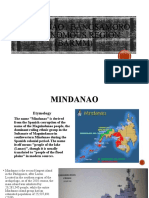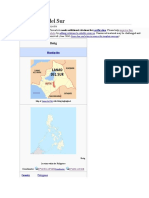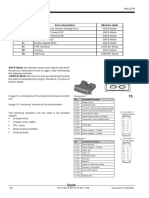0 ratings0% found this document useful (0 votes)
90 viewsHistory
History
Uploaded by
VINCENT GAYRAMONThe document summarizes key events in the Philippines, particularly in Mindanao, from the 1960s to the 1990s. It discusses the growth of the banana and pineapple plantations in the 1960s, as well as rising social unrest and violence, particularly between Muslim and Christian groups. The 1970s saw the emergence of violent paramilitary groups like the Ilaga and the Manili massacre, worsening conflicts. The 1980s brought the People Power Revolution and a focus on restoring democracy. Through the 1990s, tourism in Mindanao grew, particularly in Southern Mindanao, aided by peace talks between the government and MNLF in 1996. However, kidnappings in 1998 slowed investment and tourism.
Copyright:
© All Rights Reserved
Available Formats
Download as PPTX, PDF, TXT or read online from Scribd
History
History
Uploaded by
VINCENT GAYRAMON0 ratings0% found this document useful (0 votes)
90 views7 pagesThe document summarizes key events in the Philippines, particularly in Mindanao, from the 1960s to the 1990s. It discusses the growth of the banana and pineapple plantations in the 1960s, as well as rising social unrest and violence, particularly between Muslim and Christian groups. The 1970s saw the emergence of violent paramilitary groups like the Ilaga and the Manili massacre, worsening conflicts. The 1980s brought the People Power Revolution and a focus on restoring democracy. Through the 1990s, tourism in Mindanao grew, particularly in Southern Mindanao, aided by peace talks between the government and MNLF in 1996. However, kidnappings in 1998 slowed investment and tourism.
Original Description:
Overview of mindanao
Original Title
history
Copyright
© © All Rights Reserved
Available Formats
PPTX, PDF, TXT or read online from Scribd
Share this document
Did you find this document useful?
Is this content inappropriate?
The document summarizes key events in the Philippines, particularly in Mindanao, from the 1960s to the 1990s. It discusses the growth of the banana and pineapple plantations in the 1960s, as well as rising social unrest and violence, particularly between Muslim and Christian groups. The 1970s saw the emergence of violent paramilitary groups like the Ilaga and the Manili massacre, worsening conflicts. The 1980s brought the People Power Revolution and a focus on restoring democracy. Through the 1990s, tourism in Mindanao grew, particularly in Southern Mindanao, aided by peace talks between the government and MNLF in 1996. However, kidnappings in 1998 slowed investment and tourism.
Copyright:
© All Rights Reserved
Available Formats
Download as PPTX, PDF, TXT or read online from Scribd
Download as pptx, pdf, or txt
0 ratings0% found this document useful (0 votes)
90 views7 pagesHistory
History
Uploaded by
VINCENT GAYRAMONThe document summarizes key events in the Philippines, particularly in Mindanao, from the 1960s to the 1990s. It discusses the growth of the banana and pineapple plantations in the 1960s, as well as rising social unrest and violence, particularly between Muslim and Christian groups. The 1970s saw the emergence of violent paramilitary groups like the Ilaga and the Manili massacre, worsening conflicts. The 1980s brought the People Power Revolution and a focus on restoring democracy. Through the 1990s, tourism in Mindanao grew, particularly in Southern Mindanao, aided by peace talks between the government and MNLF in 1996. However, kidnappings in 1998 slowed investment and tourism.
Copyright:
© All Rights Reserved
Available Formats
Download as PPTX, PDF, TXT or read online from Scribd
Download as pptx, pdf, or txt
You are on page 1of 7
1960s
the banana and pine apple plantations industry boomed
Social unrest became more apparent in Southern Mindanao.
Violence was rampant.
- News headlines carries reports of killings, encounters and harassments happening
in the various parts of Mindanao especially in the areas with heavy Muslim
concentration.
The Moro struggle was much triggered by the so called Jabidah Massacre on March
17, 1968.
- Jabidah massacre was the alleged killing of Moro soldiers by members of
the Armed Forces of the Philippines (AFP) on 18 March 1968.It is also known as
the Corregidor massacre as the killing took place on Corregidor Island in the Philippines.
- This involved the merciless killing of at 28 young Muslim recruits in the Philippine
Army by their Christians superiors.
1970s
The Ilaga group became known in the region.
- they are said to be the most feared by the Muslims.
- they are the most notorious organized by the seven local Christians politicians
- they are supported by some influential Christians and logging magnets.
- Manili massacre is one of their activities wherein 70 Muslims and wounding 70
other inside the mosque and nearby house in the barrio.
- this incident worsened the conflict in the region and marked a deep scar
on the Muslim community.
Marcos regime created Department of Tourism.
- part of the Four Year Program of the Department of Tourism was the
development of tourist sites beyond Metro Manila particularly in Northern Luzon,
Zamboanga, Davao and Bicol region.
- tourism was promoted particularly in Southern Mindanao.
Peoples perception of the region was largely negative and biased due to serious
insurgency problems in Davao region, CARAGA, provinces such as Bukidnon, Misamis
Oriental and Occidental.
- the conflict between the government and the Moro National Liberation Front
(MNLF) and Moro Islamic Liberation Front (MILF).
1980s
It was common knowledge that the dictatorial government for almost 20 years
ended through a people power revolution in 1986.
The countrys democratic foundations were reestablished and the much needed
reforms were set in place.
The economy suffered from major lapses and was not moving forward both in
national and regional levels.
However, the condition could not be blamed on the government at the time since its
focus was more on bringing back democracy and investor confidence was destroyed
by the coup attempts.
1990s
Tourism growth was observed in Mindanao especially in Southern Mindanao to a more
stable and sustainable direction.
In 1992, tourism industry displayed a renewed vigor in the region despite the favorable
events which affected visitor traffic.
1n 1994, the region regained its confidence and momentum in terms of economic
growth alongside with the development thrust of the country in Mindanao.
The region opened its doors to East Asian neighbors.
Mayor Dutertes administration has the record of lowest crime giving the impression to
the local and foreign tourist that the regions local government could give them
assurance of security.
In addition, Davao envisioned itself as a center of trade, commerce and tourism in
Mindanao.
Tourist arrivals in Mindanao particularly in Southern Mindanao increased significantly
from 1994-1995 by 44% or a total of 294,702 visitors.
- 88.73% were domestic and 11.27% were foreign visitors.
With the tourist development, the land of some native folks who were lured by the
meddlers were lost.
- they sell their lands to the investors especially lands along coastline areas.
In September 1996, the Philippine government and MNLF settled their socio-political
conflict through peace talk which resulted to full recognition worldwide and
strengthen the trust and confidence not only to business sectors but also to local and
foreign tourist as well.
In 1998, the number of local and foreign investors in Mindanao started to decline.
- this was attributed to the fact that national elections held in the country and
kidnapping for ransom of foreign nationals Abu Sayaff were on the headlines that adds
injury to the image on Mindanao.
The declaration of all out war in Central Mindanao in 2001 gained varied criticism
from the different groups and organization.
The Maguindanao Massacre in November 2009 , the Killing of Catholic priest in Jolo,
Sulu, the kidnapping of media personalities and foreign nationals, the three successive
bombing in Central Mindanao on August 2013 caught the national and international
attention while in Northern part of Mindanao, incidents regarding extortion, the
offensive attack of NPA, the displacement of Indigenous people due to mining took
place.
The recent peace talks between the government and MILF which resulted to the
signing of Framework Agreement on Bangsa Moro (FAB) gained positive support for
those people who hopes to end conflict in Mindanao.
You might also like
- Exam: SC-900 Title: Microsoft Security, Compliance, and Identity Fundamentals Vendor: Microsoft Questions: 238Document52 pagesExam: SC-900 Title: Microsoft Security, Compliance, and Identity Fundamentals Vendor: Microsoft Questions: 238zawzaw htet100% (2)
- The Contemporary Muslim Movement in the PhilippinesFrom EverandThe Contemporary Muslim Movement in the PhilippinesRating: 1 out of 5 stars1/5 (1)
- mindanao-1999-PPTDocument11 pagesmindanao-1999-PPTKert ivan AnsaleNo ratings yet
- Peace and Devt-StudentsDocument12 pagesPeace and Devt-StudentskayrinaNo ratings yet
- MINDANAODocument11 pagesMINDANAOJianna Tang IndingNo ratings yet
- Brief History of Mindanao IslandDocument22 pagesBrief History of Mindanao IslandPrecean serraNo ratings yet
- Summary of The Brief History of Mindanoa IslandDocument2 pagesSummary of The Brief History of Mindanoa IslandCristina RocheNo ratings yet
- RR Diaz 1CED - CW Local and GlobalDocument2 pagesRR Diaz 1CED - CW Local and GlobalJr DiazNo ratings yet
- D 109 PHDocument50 pagesD 109 PHemsanchez100% (1)
- Philippines Factors of Century-Old Conflict and CuDocument15 pagesPhilippines Factors of Century-Old Conflict and CubpabustanNo ratings yet
- Mindanao / Bangsamoro Autonomous Region (Barmm)Document30 pagesMindanao / Bangsamoro Autonomous Region (Barmm)Janna Grace Dela CruzNo ratings yet
- Understanding The Mindanao Insurgency byDocument7 pagesUnderstanding The Mindanao Insurgency byNur MNNo ratings yet
- 1 History 3 Final LessonDocument8 pages1 History 3 Final Lessonsahidapamaloy08No ratings yet
- MoroDocument19 pagesMoroNicole Steve Tupino LambinoNo ratings yet
- 1 The Moro Uprising A Nation RebornDocument8 pages1 The Moro Uprising A Nation RebornAlnidzfar BaharanNo ratings yet
- Philippine Culture FinalsDocument25 pagesPhilippine Culture FinalsKaneki KenNo ratings yet
- Local historyDocument2 pagesLocal historyMarielle JoquiñoNo ratings yet
- Mindanao and GlobalizationDocument2 pagesMindanao and GlobalizationNell Cathlyn Española100% (2)
- Drivers of Conflict in MindanaoDocument3 pagesDrivers of Conflict in Mindanaojmdaradal26No ratings yet
- REFLECTIONDocument8 pagesREFLECTIONjoanna zambranoNo ratings yet
- Full Docx of BolDocument42 pagesFull Docx of BolHadjara PolangiNo ratings yet
- Philippines 9 Mindanao SuluDocument20 pagesPhilippines 9 Mindanao SuluConner BaderNo ratings yet
- The Involvement of Milf Against The Philippine Government: An AnalysisDocument17 pagesThe Involvement of Milf Against The Philippine Government: An AnalysisJerome EncinaresNo ratings yet
- Migrats DraftDocument9 pagesMigrats DraftBea BordadoraNo ratings yet
- Islamic ExtremistsDocument8 pagesIslamic ExtremistsPEMS Ivan Theodore P LopezNo ratings yet
- Devpath Paper Bangsamoro Peace ProcessDocument22 pagesDevpath Paper Bangsamoro Peace ProcessSean Christian DinglasanNo ratings yet
- Philippines 35Document21 pagesPhilippines 35KGNo ratings yet
- Peace and Governance: What Are The Options (Author: DR Antonio Gabriel M La Viña)Document16 pagesPeace and Governance: What Are The Options (Author: DR Antonio Gabriel M La Viña)VanessaRemoquilloNo ratings yet
- Philippines Guide Final 030812Document218 pagesPhilippines Guide Final 030812StarLink1No ratings yet
- IPRADocument2 pagesIPRAJeremyNo ratings yet
- Final Exam RangaigDocument2 pagesFinal Exam RangaigAna Farina RangaigNo ratings yet
- Postwar Era To Marawi Seige of Mindanao PhilippinesDocument3 pagesPostwar Era To Marawi Seige of Mindanao PhilippinesRebecca JordanNo ratings yet
- Brief History of Mindanao IslandDocument26 pagesBrief History of Mindanao IslandChenchen AlamanNo ratings yet
- Conflict in Mindanao Root Causes and Status: Abhoud Syed M. Lingga Institute of Bangsamoro StudiesDocument26 pagesConflict in Mindanao Root Causes and Status: Abhoud Syed M. Lingga Institute of Bangsamoro StudiesKeme DoraNo ratings yet
- Commonwealth Period - Japanese Occupation - Post War PeriodDocument4 pagesCommonwealth Period - Japanese Occupation - Post War PeriodRayNo ratings yet
- Deed of Donation 1Document40 pagesDeed of Donation 1Al-Badal HassanNo ratings yet
- The Involvement of Milf Against The Philippine Government: An AnalysisDocument19 pagesThe Involvement of Milf Against The Philippine Government: An AnalysisJerome EncinaresNo ratings yet
- Muslim Christian Relations 1971 2Document17 pagesMuslim Christian Relations 1971 2ompong42No ratings yet
- UNFINISHED - No End To Lumad Dislocation From Their Homeland The Case of The Sarangani Manobo and B'laans in Davao OccidentalDocument22 pagesUNFINISHED - No End To Lumad Dislocation From Their Homeland The Case of The Sarangani Manobo and B'laans in Davao OccidentalConzie MntajesNo ratings yet
- Brief History of Mindanao IslandDocument8 pagesBrief History of Mindanao IslandKaren CastorNo ratings yet
- Butig Lanao Del SurDocument7 pagesButig Lanao Del SurLisa Marsh100% (1)
- Brief History of Mindanao IslandDocument9 pagesBrief History of Mindanao Islandaeron gwapingsNo ratings yet
- Culture of MindanaoDocument13 pagesCulture of MindanaoJohn Allen BejoNo ratings yet
- Brief History of Mindanao IslandDocument4 pagesBrief History of Mindanao IslandKjmen 2345No ratings yet
- 222F667D-7367-4BF0-A224-33D6561FFC72Document5 pages222F667D-7367-4BF0-A224-33D6561FFC72Vasco GonsalvesNo ratings yet
- G3 - Diaspora of The MorosDocument3 pagesG3 - Diaspora of The Moroskhyle.mar05No ratings yet
- Media & Telecoms Landscape Guide - PhilippinesDocument218 pagesMedia & Telecoms Landscape Guide - PhilippinesJenine QuiambaoNo ratings yet
- Peace AdvocacyDocument4 pagesPeace AdvocacyMarnie GarcinesNo ratings yet
- Inclusive Peace in Muslim Mindanao Revisiting The Dynamics of Conflict and ExclusionDocument32 pagesInclusive Peace in Muslim Mindanao Revisiting The Dynamics of Conflict and ExclusionDax TibusNo ratings yet
- MINSUPALA - TarpapelDocument9 pagesMINSUPALA - TarpapelTresele Escara LudrietaNo ratings yet
- Bangsamoro IssueDocument21 pagesBangsamoro IssueIejo RamosNo ratings yet
- The Spanish Jesuits 'Tamontaka Experiment'Document4 pagesThe Spanish Jesuits 'Tamontaka Experiment'Rina Jane FernandezNo ratings yet
- MindanaoDocument3 pagesMindanaoJohnmeri Dale Genodiala BaldoNo ratings yet
- Second TermDocument3 pagesSecond TermAdonis GaoiranNo ratings yet
- Mindanaoan IdentityDocument15 pagesMindanaoan Identityclvendarl.avthulhalickNo ratings yet
- Module Samal 1Document56 pagesModule Samal 1Elsie Joy LicarteNo ratings yet
- Final Research Proposal PDFDocument21 pagesFinal Research Proposal PDFhansNo ratings yet
- Brief History of Mindanao Island Handsout 1Document4 pagesBrief History of Mindanao Island Handsout 1ELIZAREANo ratings yet
- Name: Abdullah, Aslema D. - Course & Year: BSA - 1DDocument4 pagesName: Abdullah, Aslema D. - Course & Year: BSA - 1DAzilah AbdullahNo ratings yet
- ProQuestDocuments 2018 03 23Document11 pagesProQuestDocuments 2018 03 23VINCENT GAYRAMONNo ratings yet
- Cost12 Study03 PDFDocument12 pagesCost12 Study03 PDFVINCENT GAYRAMON100% (1)
- Problems and Solution For CVPDocument12 pagesProblems and Solution For CVPVINCENT GAYRAMONNo ratings yet
- Gayramon Web Store ProductsDocument4 pagesGayramon Web Store ProductsVINCENT GAYRAMONNo ratings yet
- Statement of Comprehensive IncomeDocument2 pagesStatement of Comprehensive IncomeVINCENT GAYRAMONNo ratings yet
- Doing Research... : Has Never Been This Fun and Exciting!Document47 pagesDoing Research... : Has Never Been This Fun and Exciting!VINCENT GAYRAMONNo ratings yet
- Setup Vendor, Customer and Item List.: Put The Abbreviation Ex. RRM (Rebecca R. Maquiling)Document1 pageSetup Vendor, Customer and Item List.: Put The Abbreviation Ex. RRM (Rebecca R. Maquiling)VINCENT GAYRAMONNo ratings yet
- Students Netsuite QuizDocument1 pageStudents Netsuite QuizVINCENT GAYRAMONNo ratings yet
- The Silicate Solution: Paints With Benefits by Tanya JewellDocument3 pagesThe Silicate Solution: Paints With Benefits by Tanya JewellMohan KumarNo ratings yet
- 4ème Cours - Irrigation and DrainageDocument4 pages4ème Cours - Irrigation and DrainageBroomNo ratings yet
- Money LaunderingDocument52 pagesMoney LaunderingMohamed AbassorNo ratings yet
- Milk Supplying in Student Cafe: 1. BackgroundDocument28 pagesMilk Supplying in Student Cafe: 1. BackgroundYosef KirosNo ratings yet
- Sluts and Riot GirlsDocument16 pagesSluts and Riot Girlsalmani5629No ratings yet
- Food Chain Homework Answer KeyDocument8 pagesFood Chain Homework Answer Keyafmoirvox100% (1)
- Case Digest On PatentsDocument24 pagesCase Digest On PatentsEnriqueAngeloDolotallas100% (1)
- Center List For Exam CAIIB PDFDocument2 pagesCenter List For Exam CAIIB PDFrajeshNo ratings yet
- Death and Dying: Presented by Dr. Judith SugayDocument21 pagesDeath and Dying: Presented by Dr. Judith SugayMichelle HutamaresNo ratings yet
- 'Expert Advisor Based On The - New Trading Dimensions - by Bill Williams - MQL5 ArticlesDocument12 pages'Expert Advisor Based On The - New Trading Dimensions - by Bill Williams - MQL5 Articlesradityaananta2000100% (2)
- Evidence and Public Good in Educational Policy Research and PracticeDocument245 pagesEvidence and Public Good in Educational Policy Research and PracticemarnekibNo ratings yet
- Using Visual Supports With Young Children With AutDocument9 pagesUsing Visual Supports With Young Children With AutWayang PujiNo ratings yet
- The Art of KissingDocument2 pagesThe Art of Kissingsummerfuck0% (1)
- Lesson Plan #2: Collaboration: Grade: 2 Social Studies Strand: GeographyDocument5 pagesLesson Plan #2: Collaboration: Grade: 2 Social Studies Strand: Geographyvidareljic22100% (1)
- 3D PrintingDocument3 pages3D Printingabhay4meggiNo ratings yet
- Department of Education: A Detailed Lesson Plan in English 4 Fourth Grading PeriodDocument8 pagesDepartment of Education: A Detailed Lesson Plan in English 4 Fourth Grading PeriodCrisalyn Devilla ManlapigNo ratings yet
- Lumayna vs. COADocument11 pagesLumayna vs. COASarah Beth TomasNo ratings yet
- Lahore Air Quality Index (AQI) and Pakistan Air Pollution AirVisualDocument1 pageLahore Air Quality Index (AQI) and Pakistan Air Pollution AirVisualJannat ImranNo ratings yet
- Kapayapaan Integrated School SY: - Dressmaking/Tailoring Tle-8 Summative Test SY-2019-2020Document3 pagesKapayapaan Integrated School SY: - Dressmaking/Tailoring Tle-8 Summative Test SY-2019-2020maria cristina pascual100% (1)
- Error Code Error Description Machine State 15 19 23 27 31 35 39 70 Fault Table "A"Document2 pagesError Code Error Description Machine State 15 19 23 27 31 35 39 70 Fault Table "A"AdamNo ratings yet
- Your Part in Neste's JourneyDocument3 pagesYour Part in Neste's JourneyMell BuntulaNo ratings yet
- AC & Sons BLDG., Almanza Uno, Alabang-Zapote Road, Las Piñas CityDocument2 pagesAC & Sons BLDG., Almanza Uno, Alabang-Zapote Road, Las Piñas CityNicole Dang BallaretNo ratings yet
- Fats LabsDocument43 pagesFats LabsMunibah AhsanNo ratings yet
- Good Quotes VenkatDocument10 pagesGood Quotes Venkatbhappy4ever100% (2)
- War Photographer ThesisDocument4 pagesWar Photographer Thesisjessicaandersonseattle100% (2)
- Jyothsna ReportDocument109 pagesJyothsna ReportThalapathy Ra UngammaNo ratings yet
- How To Configure Crystal Enterprise To Use SMTPDocument12 pagesHow To Configure Crystal Enterprise To Use SMTPregistweb9673No ratings yet
- Dbs Paylah Hawker ListDocument255 pagesDbs Paylah Hawker ListdisekjmNo ratings yet
- Queen Interview 01-19-1978 "Circus Magazine"Document4 pagesQueen Interview 01-19-1978 "Circus Magazine"SunnyNo ratings yet

































































































